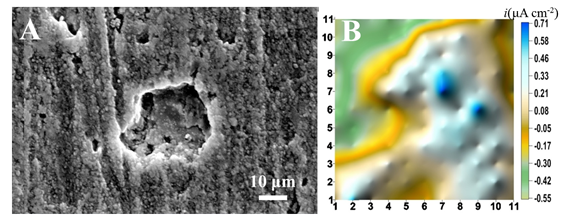 科研进展 科研进展海洋环境金属腐蚀机理的研究 海洋环境金属腐蚀机理的研究
段继周课题组用电化学手段研究发现硫酸盐还原菌能够从极化的碳钢直接获得电子催化H2的产生,硫酸盐还原菌生物膜与碳钢间的直接电子传递是导致碳钢阴极反应加速的根本原因。黄彦良课题组研制了一种研究浪花飞溅区腐蚀电化学行为的装置,为在薄层液膜下浪花飞溅区腐蚀电化学行为研究提供了便捷、有效的手段。张盾课题组将将微区电化学测试技术应用到硫酸盐还原菌对海洋常用典型金属腐蚀机理研究中,探讨海洋腐蚀细菌对局部腐蚀的电化学反应的作用机制。研究证实了铜表面电化学性质的不均匀性,同时发现硫酸盐还原菌生物膜的附着改变了电极表面电流分布特征,导致大面积阴极区的形成,从而诱发孔蚀。 相关结果在Electrochemistry Communications和欧洲腐蚀会议等期刊会议发表。 [1] Lin Yu, Jizhou Duan*, Xiangqian Du, Yanliang Huang, Baorong Hou. Accelerated anaerobic corrosion of electroactive sulfate-reducing bacteria by electrochemical impedance spectroscopy and chronoamperometry. Electrochemistry Communications, 2013, 26, 101-104. [2] Dun Zhang*, Qi Bao, Jiajia Wu. Effect of Sulphate-Reducing Bacteria on the Corrosion of Q235 Steels in 3.5 wt.% NaCl Media. European corrosion congress 2013, 2013.09.01-05, P1613, Estoril, Portugal. 采用微区电化学测试技术研究铜局部腐蚀机理(A:铜在含SRB海水中浸泡14天后表面SEM照片;B:铜阵列电极表面在含SRB海水中浸泡5天后电流分布图) The investigation of the local corrosion mechanism of Cu using microzone electrochemical testing technique (A: SEM image of the Cu immersed in seawater containing SRB for 14 days; B: the surface current distribution of the Cu wire beam electrode immersed in seawater containing SRB for 5 days) |
邮编:266071 联系电话:0532-82866291,传真: 0532-82898960
